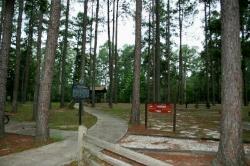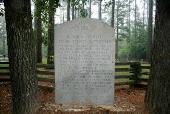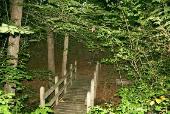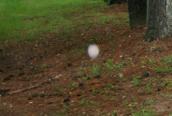


Monument at Poison Spring
This monument dating from
the early 20th century now
stands near the entrance to
the park.
This monument dating from
the early 20th century now
stands near the entrance to
the park.
Battlefield Display
A well designed interpretive
kiosk helps visitors better
understand the fighting of the
Battle of Poison Spring.
A well designed interpretive
kiosk helps visitors better
understand the fighting of the
Battle of Poison Spring.
ExploreSouthernHistory.com - The Battle of Poison Spring, Arkansas
ExploreSouthernHistory.com - The Battle of Poison Spring, Arkansas
The Battle of Poison Spring, Arkansas

| Poison Spring State Park Key areas of the battlefield can be viewed at the park, located 10 miles west of Camden, Arkansas. |
"They did kill and scalp some..."
A startling and bloody tragedy, the Battle of
Poison Spring took place on April 18, 1864,
during the Arkansas phase of the Red River
Campaign.
The campaign resulted from a bizarre Union
plan to seize control of parts of Louisiana
and Texas. Over the objections of Gen. U.S.
Grant, the North diverted large numbers of
troops for an effort to seize the Red River
valley as far upstream as Shreveport.
The plan called for one Union army to
advance up the Red River through Louisiana,
while a second came south from Little Rock
and Fort Smith in Arkansas. Union
authorities hoped the two would converge
near Shreveport and either crush or drive off
the outnumbered Confederate troops in the
area.
Southern commanders in the region proved
far more aggressive than their Union counter-
parts, however, and struck hard against the
Louisiana wing of the attack, driving it back
even as the Arkansas phase of the campaign
was getting underway.
Major General Frederick Steele had pushed
deep into southern Arkansas when supply
shortages and increasing Confederate
resistance convinced him that the campaign
was in trouble. He fell back on Camden,
where his men took cover behind the town's
fortifications.
Due to the critical supply shortages facing
the Federals, Steele sent out a force of
around 670 men with 2 cannon to escort a
train of 200 wagons sent to collect corn 20
miles west of Camden. The command was
reinforced slightly and by April 18, 1864, Col.
James M. Williams led a total force of around
1,160 men with 4 pieces of artillery.
As the Union raiders approached Poison
Spring on their way back to Camden, they
were stunned to learn that Confederate Gen.
John S. Marmaduke and moved in between
them and their destination with 3,600
Confederate soldiers and 12 pieces of
artillery.
The result was the bloody Battle of Poison
Spring, Arkansas, one of the most complete
Union defeats of the war in the West.
More mobile than the slow moving Union
wagon train, Marmaduke was able to pick his
ground and set a trap for the oncoming
Federals.
Williams initially pushed the Confederate
skirmishers back, but when he learned of the
strength of the enemy force he took up a
defensive position along the Washington-
Camden road to protect the vital wagons.
Poison Spring took place on April 18, 1864,
during the Arkansas phase of the Red River
Campaign.
The campaign resulted from a bizarre Union
plan to seize control of parts of Louisiana
and Texas. Over the objections of Gen. U.S.
Grant, the North diverted large numbers of
troops for an effort to seize the Red River
valley as far upstream as Shreveport.
The plan called for one Union army to
advance up the Red River through Louisiana,
while a second came south from Little Rock
and Fort Smith in Arkansas. Union
authorities hoped the two would converge
near Shreveport and either crush or drive off
the outnumbered Confederate troops in the
area.
Southern commanders in the region proved
far more aggressive than their Union counter-
parts, however, and struck hard against the
Louisiana wing of the attack, driving it back
even as the Arkansas phase of the campaign
was getting underway.
Major General Frederick Steele had pushed
deep into southern Arkansas when supply
shortages and increasing Confederate
resistance convinced him that the campaign
was in trouble. He fell back on Camden,
where his men took cover behind the town's
fortifications.
Due to the critical supply shortages facing
the Federals, Steele sent out a force of
around 670 men with 2 cannon to escort a
train of 200 wagons sent to collect corn 20
miles west of Camden. The command was
reinforced slightly and by April 18, 1864, Col.
James M. Williams led a total force of around
1,160 men with 4 pieces of artillery.
As the Union raiders approached Poison
Spring on their way back to Camden, they
were stunned to learn that Confederate Gen.
John S. Marmaduke and moved in between
them and their destination with 3,600
Confederate soldiers and 12 pieces of
artillery.
The result was the bloody Battle of Poison
Spring, Arkansas, one of the most complete
Union defeats of the war in the West.
More mobile than the slow moving Union
wagon train, Marmaduke was able to pick his
ground and set a trap for the oncoming
Federals.
Williams initially pushed the Confederate
skirmishers back, but when he learned of the
strength of the enemy force he took up a
defensive position along the Washington-
Camden road to protect the vital wagons.
By the time the fight was over, the Southern
troops had scored a major victory. Union
losses were estimated at 204 killed or
missing and 97 wounded. They also lost 4
pieces of artillery, 170 wagons and 1,200
mules. Confederate losses, by comparison,
were 13 killed, 81 wounded and 1 missing.
The Confederate victory at the Battle of
Poison Spring was marred by allegations
that African American soldiers from the 1st
Kansas Colored Volunteers (U.S.) were
murdered when they tried to retreat from the
field.
The site of the battle is now on public lands
and can be explored at Poison Spring State
Park about 10 miles northwest of Camden,
Arkansas.
The park is located on a portion of the
battlefield and the surrounding property,
although undeveloped, is also preserved.
The park is on Highway 76, just off Highway
24, northwest of Camden and offers
picnicking, a walking trail down into the
ravine and along the stream coming from
Poison Spring, an interpretive shelter with
panels explaining the battle, markers and
monuments and a view of the battlefield.
troops had scored a major victory. Union
losses were estimated at 204 killed or
missing and 97 wounded. They also lost 4
pieces of artillery, 170 wagons and 1,200
mules. Confederate losses, by comparison,
were 13 killed, 81 wounded and 1 missing.
The Confederate victory at the Battle of
Poison Spring was marred by allegations
that African American soldiers from the 1st
Kansas Colored Volunteers (U.S.) were
murdered when they tried to retreat from the
field.
The site of the battle is now on public lands
and can be explored at Poison Spring State
Park about 10 miles northwest of Camden,
Arkansas.
The park is located on a portion of the
battlefield and the surrounding property,
although undeveloped, is also preserved.
The park is on Highway 76, just off Highway
24, northwest of Camden and offers
picnicking, a walking trail down into the
ravine and along the stream coming from
Poison Spring, an interpretive shelter with
panels explaining the battle, markers and
monuments and a view of the battlefield.

Battle of Poison Spring
The kiosk provides visitors
information on the battle,
much of which took place in
the adjoining road.
The kiosk provides visitors
information on the battle,
much of which took place in
the adjoining road.

Bridge over Poison Spring
A nature trail leads down into
a steep ravine where visitors
find a footbridge leading over
water flowing from the spring.
A nature trail leads down into
a steep ravine where visitors
find a footbridge leading over
water flowing from the spring.

Ghost at Poison Spring?
Hundreds of soldiers died at
the Battle of Poison Spring
and photographers often
capture unusual things on
camera at the battlefield.
Hundreds of soldiers died at
the Battle of Poison Spring
and photographers often
capture unusual things on
camera at the battlefield.







Battle of Poison Spring - In Depth
Battle of Poison Spring - Union Report
Battle of Poison Spring - Confederate
Report
Poison Spring State Park - Online Tour
Ghosts at Poison Spring Battlefield?
Books on the Civil War in Arkansas
Historic Sites in Arkansas
Explore other Southern Historic Sites
Battle of Poison Spring - Union Report
Battle of Poison Spring - Confederate
Report
Poison Spring State Park - Online Tour
Ghosts at Poison Spring Battlefield?
Books on the Civil War in Arkansas
Historic Sites in Arkansas
Explore other Southern Historic Sites

Historic Sites in Arkansas
Arkansas Post National Memorial
Eureka Springs, Arkansas
Historic Sites & Points of Interest
Fort Smith National Historic Site
Hot Springs National Park
Massard Prairie Battlefield Park
Pea Ridge National Military Park
Petit Jean State Park
Prairie Grove Battlefield State Park
Arkansas Post National Memorial
Eureka Springs, Arkansas
Historic Sites & Points of Interest
Fort Smith National Historic Site
Hot Springs National Park
Massard Prairie Battlefield Park
Pea Ridge National Military Park
Petit Jean State Park
Prairie Grove Battlefield State Park

Custom Search
| Copyright 2011 by Dale Cox All rights reserved. |